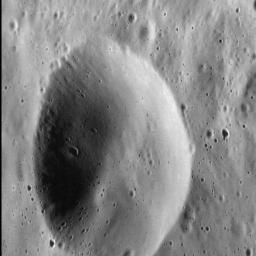The MESSENGER spacecraft flies over the surface of Mercury at several kilometers per second. Have you ever wondered what it would look like to be there in person, able to look out the window of your spacecraft and survey the landscape below?
If you did, you might see a vista like that in the image above. Here, we see a small, simple crater situated on the eastern rim of the larger Verdi impact basin, which is some 145 km (90 mi.) in diameter. With the Sun shining from the left of our field of view, the north-facing wall of the crater is in shadow. At this altitude, we can see smaller, superposed craters down to about 60 m (about 200 ft.) in diameter. There are also some very subtle striations visible along the large crater's north-facing wall, which may have formed by the down-slope movement of material after the crater formed.
This image was acquired as a high-resolution targeted observation. Targeted observations are images of a small area on Mercury's surface at resolutions much higher than the 200-meter/pixel morphology base map. It is not possible to cover all of Mercury's surface at this high resolution, but typically several areas of high scientific interest are imaged in this mode each week.
Date acquired: October 05, 2014
Image Mission Elapsed Time (MET): 54856392
Image ID: 7190091
Instrument: Narrow Angle Camera (NAC) of the Mercury Dual Imaging System (MDIS)
Center Latitude: 64.4°
Center Longitude: 194.4° E
Resolution: 27 meters/pixel
Scale: The crater in this image is 13 km (8 mi.) in diameter
Incidence Angle: 64.5°
Emission Angle: 51.9°
Phase Angle: 116.4°
North is to the right in this image.
The MESSENGER spacecraft is the first ever to orbit the planet Mercury, and the spacecraft's seven scientific instruments and radio science investigation are unraveling the history and evolution of the Solar System's innermost planet. During the first two years of orbital operations, MESSENGER acquired over 150,000 images and extensive other data sets. MESSENGER is capable of continuing orbital operations until early 2015.
For information regarding the use of images, see the MESSENGER image use policy.

 Planetary Data System
Planetary Data System












